
![]()
Search the Journey to Forever website – click HERE
|
Journey to Forever: Make a donation |
Navigation
Contact usTo Keith Addison Handmade Projects |
Houses that fit
A straw bale house is very green and "ecological". Or maybe it's not: maybe it would be even more green and ecological to compost the straw and use the compost to help rejuvenate the depleted soil the straw came from.
Or it might be better to mix the straw with clay to make bricks. But baking bricks means burning lots of wood in a kiln -- fine if there's plenty of wood (and it's an efficient kiln). And bricks then need cement to stick them together -- too expensive for many, and making cement needs high temperatures and a lot of energy.
If you live near a volcano, you could mix volcanic ash with lime to make a cheap, strong cement that doesn't need heating.
If not, it might be better to use the clay to make an adobe (mud) house and use the straw to thatch the roof.
Or make a clay roof, fill the house with the straw and burn it to bake the clay -- then you'll have a weatherproof ceramic house.
Which is best? It all depends.
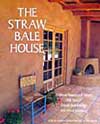 "The Straw Bale House" by David Bainbridge, 1994
"The Straw Bale House" by David Bainbridge, 1994
How to build a well insulated, sturdy, beautiful house using straw bales as the building blocks. Details, plans and photographs. Buy at Amazon.com: The Straw Bale House
"House of Straw -- Straw Bale Construction Comes of Age", Energy Efficiency and Renewable Energy (EREN), US Department of Energy.
Construction techniques discussed in this booklet focus on building resource-efficient and energy-conserving homes, without sacrificing affordability or quality. In a cooperative demonstration project between the US Department of Energy, the U. Department of Housing and Urban Development, and the Navajo Nation, current home designs on the Navajo reservation were evaluated and recommendations were made to improve quality and lower the costs. The resulting design utilized straw-bale wall construction. 8,000-word illustrated booklet, download pdf (440kb):
http://www.grisb.org/publications/pub23.pdf
Straw Bale Construction -- Sustainable Building Sourcebook, from the City of Austin's Green Building Program. 2,250-word online resource: Definition, Considerations, Commercial Status, Implementation Issues, Guidelines, Resources: Professional Assistance, Components / Materials / Systems, General Assistance, Internet Resources
http://www.greenbuilder.com/sourcebook/strawbale.html
Surfin' StrawBale -- large collection of strawbale building links and resources.
http://mha-net.org/html/sblinks.htm
The Last Straw Journal -- "In quarterly publication since 1993, The Last Straw Journal is the subscriber-supported, reader-written international grassroots journal of straw bale construction and natural building, providing up-to-date news, inspiration, and information on techniques, projects, issues, materials, and more." (It ain't free.)
http://www.strawhomes.com/
Some free articles available online in the back issue index:
http://www.strawhomes.com/backissues.html
Strawbale Construction email discussion group:
To Subscribe: strawbale-subscribe@crest.org
Strawbale Construction discussion group home page:
http://listserv.repp.org/mailman/listinfo/strawbale_listserv.repp.org
For composting, see our Composting pages -- composting is a technology that's infinitely adaptable and almost always appropriate, but that doesn't mean you must always compost everything.
Peasants in India, and elsewhere, often use cattle dung for fuel. Agricultural scientist Sir Albert Howard, the man who first developed scientific composting, was looking for a way for the peasants to extend the small amount of manure left over for use as fertilizer. Compost extends manure by four times, and is much more effective than pure manure. It meant the peasants could have it both ways.
Southern African tribes use cattle dung to make floors for their huts -- very nice floors, a bit like cork.
Fired Clay Bricks -- A New Technique for Production
http://archive.idrc.ca/nayudamma/brique_56e.html
Cement Made with Volcanic Ash
http://archive.idrc.ca/nayudamma/cement_58e.html
Charmaine R Taylor's Dirt Cheap Builder -- This is the place for books, resources, information on alternative building. 300+ books and videos for dirt-cheap housebuilding: Building With Lime, Cob & Earthen, Cordwood & Timberframe, Design Your Home, Dirt Cheap Houses & Papercrete, Heat: Stoves & Ovens, Off the Grid Homesteading, Practical: Roof, Floor, Plumb, Wire, Greywater, Small Projects, Solar Cooking, Stone Houses & Walls, Straw Bale & Light Straw Clay, and more. http://store.yahoo.com/dirtcheapbuilderbooks/index.html
 "All About Lime: A Basic Information Guide for Natural Building" by Charmaine R. Taylor, Taylor Publishing.
"All About Lime: A Basic Information Guide for Natural Building" by Charmaine R. Taylor, Taylor Publishing.
Answers many questions on lime and gypsum -- when to use each, how to make a natural cement, dry up mud on the worksite, and stabilize soil for earthen bricks (for Cinva Ram block presses and others). Lime is an amazing, very versatile building material which can be used on the ground, foundation, walls; for plasters, mortars, cements, garden and land tilth, and in the waste/septic systems. Chapters on plaster and mortar give recipes and current recommendations on application and use, an interview with professional straw bale plasterers, a history of how lime was used for building, and how it can be used again for an earth friendly alterative to Portland cement. Resources, bibliography, photographs, technical articles. From Dirt Cheap Builder:
http://store.yahoo.com/dirtcheapbuilderbooks/allaboutlime.html
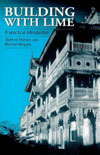 "Building With Lime: A Practical Introduction" by Stafford Holmes and Michael Wingate, 1997, Intermediate Technology; ISBN 1853393843
"Building With Lime: A Practical Introduction" by Stafford Holmes and Michael Wingate, 1997, Intermediate Technology; ISBN 1853393843
Extensive handbook for construction uses of lime for floors, washes, wattle & daub, plasters, moldings, mortars and more. Clearly presented technical information, tests, and drawings. 312 pages, many b/w photos, illustrations. Great 'how to' book, solid reference. Buy at Amazon.com: Building With Lime
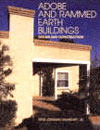 "Adobe and Rammed Earth Buildings -- Design and Construction" by Paul Graham McHenry, 1984, Reprint edition 1989, University of Arizona Press, ISBN 0816511241
"Adobe and Rammed Earth Buildings -- Design and Construction" by Paul Graham McHenry, 1984, Reprint edition 1989, University of Arizona Press, ISBN 0816511241
Adobe and rammed earth buildings are cheap, environmentally friendly and can last for ages. This is a technical manual written to provide information for professionals. Alternative design details to meet all situations and climates. Detailed information, diagrams and photographs, in-depth design considerations. Essential guide for anyone serious about building with adobe. From Dirt Cheap Builder:
http://store.yahoo.com/dirtcheapbuilderbooks/adandramearb.html
"Understanding Adobe" by Balla Sidibe, Technical Paper # 24, Understanding Technology Series, Volunteers In Technical Assistance (VITA) -- Practical information on the use of adobe in block making in developing countries. Full text online at CD3WD 3rd World Development online library:
http://www.cd3wd.com/cd3wd_40/vita/adobe/en/adobe.htm
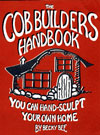 "Cob Builders Handbook: You Can Hand-Sculpt Your Own Home" by Becky Bee, 1997, Chelsea Green, ISBN 0965908208
"Cob Builders Handbook: You Can Hand-Sculpt Your Own Home" by Becky Bee, 1997, Chelsea Green, ISBN 0965908208
One-third of the world's population lives in homes made of unbaked earth -- "cob". Fifty thousand cob buildings are still in use in England today, most of them built in the 18th and 19th centuries. Not a fad or craze, cob is a building technique that has stood the test of time. Cob building is environmentally friendly, and it's easy -- cob is a flexible and forgiving medium. Earth, sand and straw are mixed together and massaged onto the foundation, creating thick load-bearing walls. It's like hand-sculpting a giant pot to live in. A cob house costs as little as one-sixth of a conventional house, and it's comfortable, warm in winter, cool in summer, and the walls muffle sound. Cob houses are long-lasting -- and no, they don't dissolve in the first downpour. Becky Bee has built them in the US, Australia, New Zealand, Central America, and Samoa. All the necessary basics on design, site selection, making and using cobs. Written for people with or without building experience. Buy at Amazon.com: Cob Builders Handbook
 "Building with Papercrete and Paper Adobe" by Gordon Solberg, 1999, Remedial Planet, ISBN 1928627005
"Building with Papercrete and Paper Adobe" by Gordon Solberg, 1999, Remedial Planet, ISBN 1928627005
Build a home for next to nothing -- and do some recycling at the same time. Papercrete is made of recycled paper or cardboard, sand, and Portland cement. It's strong, light, a good insulator and very cheap, you can mould it in any shape (like papier maché), it doesn't go mouldy, swell or burn. Paper adobe is even cheaper -- it's made of earth and paper or cardboard. Papercrete isn't new -- it was patented in 1928 but was too cheap to market at a profit. Now people are building homes with it, for as little as US$1 per square foot, or even less. This book tells it all with easy-to-understand text, photos, and resource information. From the Papercrete site:
http://www.zianet.com/papercrete/book.html
Papercrete News:
http://www.zianet.com/papercrete/index.html
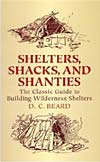 "Shelters, Shacks & Shanties" by D.C. Beard, 1914, Classic Reprint Series.
"Shelters, Shacks & Shanties" by D.C. Beard, 1914, Classic Reprint Series.
A bestseller solely on breadth of material and Beard's skilful illustrations, but his optimistic writing style also made readers feel that not only could they build the structures illustrated but that it would be a pleasure doing it. The range covers a near endless variety of structures from a hogan to a log cabin, with emphasis on temporary shelters built by woodsmen. He describes how to build them in every conceivable circumstance, including in dirt banks with sod roofs, on poles over a marsh or on a floating base on a peat bog. Also covers signal towers, tree houses, food caches and notched log ladders, all in great variety. Along the way he discusses how to use an axe to achieve all of this, as well as explaining how to make a variety of doors and fittings, from straightforward catches to secret latches and locks. With 330+ illustrations. Buy at Amazon.com: Shelters, Shacks & Shanties
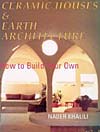 "Ceramic Houses & Earth Architecture: How to Build Your Own" by Nader Khalili, 1986, 4th Edition 1996, CalEarth Press, ISBN 1-889625-01-9
"Ceramic Houses & Earth Architecture: How to Build Your Own" by Nader Khalili, 1986, 4th Edition 1996, CalEarth Press, ISBN 1-889625-01-9
Step-by-step instructions on how to construct, glaze, and fire adobe and rammed earth buildings. Buy at Amazon.com: Ceramic Houses and Earth Architecture
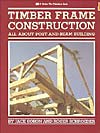 "Timber Frame Construction" by Jack Sobon and Roger Schroeder, 1984.
"Timber Frame Construction" by Jack Sobon and Roger Schroeder, 1984.
The book to get you started. Based on a starter project, the construction of a timber frame garden shed, it gives the history and basic principles of timber framing, describes the various joints, their uses and how to cut them, advises on design, raising and closing in, and provides all the information needed for the project and a good deal more, in precise and interesting text. Beautifully illustrated throughout with black-and-white drawings and photographs. Buy at Amazon.com: Timber Frame Construction
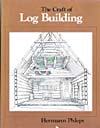 "The Craft of Log Building" by Hermann Phleps (translated from the original German by Roger MacGregor), 1942
"The Craft of Log Building" by Hermann Phleps (translated from the original German by Roger MacGregor), 1942
The definitive work on European horizontal log construction. Properties of wood, tree species, felling and seasoning, foundations and sills, log walls, cornerwork and partition wall joinery, roof framing, and everything else. Thorough treatment, well illustrated with photographs and Phleps's excellent and clear drawings. Buy at Amazon.com: The Craft of Log Building
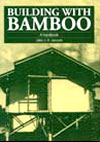 "Building With Bamboo" by Jules J. A. Janssen, 1995
"Building With Bamboo" by Jules J. A. Janssen, 1995
This handbook brings together the practical experience of engineers working in the field, and research programs testing the properties of bamboo. Shows how bamboo has been used in different designs in developing countries and describes the varying properties and uses of different types of bamboo. How bamboo can be harvested, seasoned and jointed to form walls, doors and windows, roofs, floors, ceilings, roof trusses and bridges, and how to weave bamboo. Experiences of Dutch engineers in colonial Indonesia long ago building houses, roads and bridges, combined with similar original English material, plus the results of modem research, with the addition of the latest knowledge and a case study from Costa Rica. Buy at Amazon.com: Building With Bamboo
 "Complete Book of Underground Houses : How to Build a Low-Cost Home" by Robert L. Roy, 1994, Sterling, ISBN 0806907282
"Complete Book of Underground Houses : How to Build a Low-Cost Home" by Robert L. Roy, 1994, Sterling, ISBN 0806907282
Choose an earth-sheltered or underground home and let an expert show you how to excavate and build it. Roy is director of the Earthwood Building School. Detailed instructions on choosing a site, excavating and building, waterproofing, insulation, drainage and more, with case studies, photos and diagrams, and further resources. Written with care to help non-professionals avoid the pitfalls. Buy at Amazon.com: Complete Book of Underground Houses
Green Home Building: Sustainable Architecture: Earth Sheltering -- Earth-Sheltered Houses -- resources, books, plans, links
http://www.greenhomebuilding.com/keepcool.htm
Sustainable Building Sourcebook -- from the City of Austin's Green Building Program. Covers water -- indoor water conservation, composting toilets, greywater irrigation, harvested rainwater, etc.; energy -- passive solar design, photovoltaic systems, gas water heating systems, energy efficient appliances, lighting, and more; building materials, solid waste, green building professionals directory, and more.
http://www.greenbuilder.com/sourcebook/
Greenbuilding email discussion group:
To Subscribe: greenbuilding-subscribe@crest.org
Greenbuilding discussion group home page:
http://listserv.repp.org/mailman/listinfo/greenbuilding_listserv.repp.org
 "Shelter" by Lloyd Kahn, Bob Easton (editors), reprint 1996, Shelter Pubns, ISBN 067976948X
"Shelter" by Lloyd Kahn, Bob Easton (editors), reprint 1996, Shelter Pubns, ISBN 067976948X
More than a thousand photographs and drawings of houses around the world in this just-reprinted classic, plus text descriptions and even plans. An eye-opener and an inspiration. Kahn has been a carpenter and a photographer, and an editor of Whole Earth Catalog and Domebook 2 in the 1960s. Shelter is the record of his wanderings in the 1970s to document building traditions throughout the world, and the counter-culture in the US. Caves, huts, barns, yurts, domes, stud-frame, mortise and tenon, tree houses and more, made of stone, wood, adobe, rammed earth, sod, plaster, canvas, reed, bamboo. Buy at Amazon.com: Shelter
"Architecture Without Architects" by Bernard Rudofsky, 1964, Doubleday, ISBN 0-385-07487-5; 1996, John Wiley & Sons, ISBN 0902620789; "Architecture Without Architects -- A Short Introduction to Non-Pedigreed Architecture", Reprint edition 1987, University of New Mexico Press, ISBN 0826310044
Originally an exhibitation at the Museum of Modern Art in New York, this is a collection of extraordinary photographs of habitations, from the Dogon villages south of Timbuctou to underground villages carved out of the loess soil in China. It's what Rudofsky calls "communal architecture", produced by the spontaneous and continuing activity of a whole people with a common heritage, acting within a community of experience. What they have in common is that they fit. Rudofsky offers them as lessons on how to live and let live. Buy at Amazon.com: Architecture Without Architects
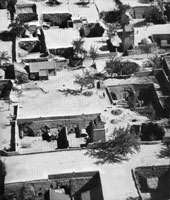
Underground loess village in China
Appropriate technology
Appropriate technology resources
- Agriculture resources
- Wood resources
Blacksmithing
Wood fires that fit
Houses that fit
Water-powered water pumps
Journey to Forever and AT
- Chinese watering cans
- Handmade Projects watering can plans
- Hoe for victory!
- Billhooks and sickles
A better rat trap
- Rats and owls
- Chinese rat trap
- How to make a Chinese rat trap
- Bucket rat trap
Appropriate technology subjects